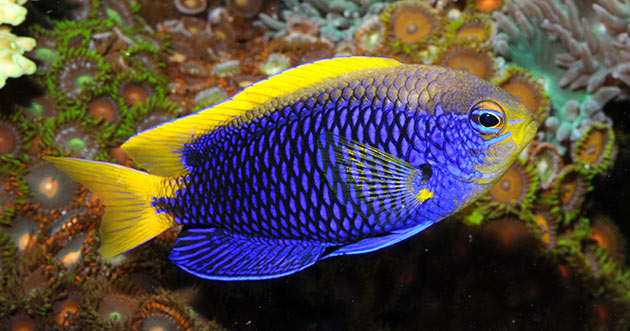
Before you start selecting fishes for your reef aquarium from the LiveAquaria website, you need to do some planning. Fortunately, the species accounts for each fish available on this website provide information about their “invertebrate-friendliness” (i.e., a compatibility chart). The best way to put together a reef aquarium fish community is to go through the website (or a good marine aquarium fish guide) and write down the fishes that strike your fancy.
In addition, consider the following important questions regarding marine fish behavior and habit that should be answered before selecting fishes for your coral reef aquarium.
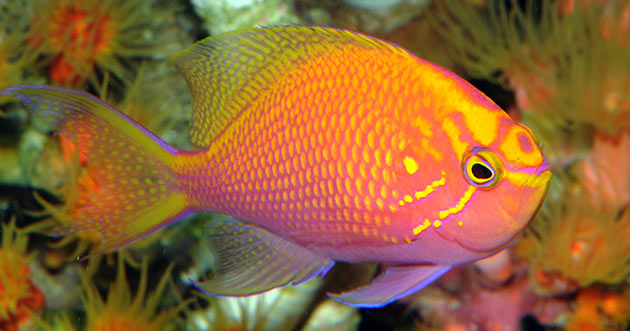
Serranocirrhitus latus |
Will the Fish Knock or Flip Over My Corals?
There are some fish that do not nip at cnidarians, but instead damage them by accidentally or intentionally displacing the coral colony or surrounding reef structure. When a fish knocks over a piece of coral the cnidarians tissue may be torn or it may land on another stinging coral or anemone, resulting in irreparable damage.
Some species accidentally dislodge coral colonies as they move through the rocky interstices (e.g., Morays) or clamor over the aquarium aquascaping (e.g., Epaulette Sharks). There are also fishes that intentionally dislocate pieces of rubble, rock or coral colonies when hunting. There are a number of Wrasses (e.g., Coris spp., Rockmover Wrasse ((Novaculichthys taeniourus)) that will grasp a piece of rubble in their jaws, lift it off the bottom and throw it to one side in an attempt to expose worms and crustaceans underneath. Larger individuals have also been known to rearrange aquarium décor, which sometimes results in coral colonies rolling down the reef or being smashed by a displaced piece of live rock. But Wrasses are not the only “rubble flippers.” Some Goatfishes employ their nimble chin barbels to flip over rocks and smaller corals, while there are Triggerfishes use their jaws to relocate rubble. (Triggerfish that engage in this behavior are also likely to bite off the tips of branching stony corals.)
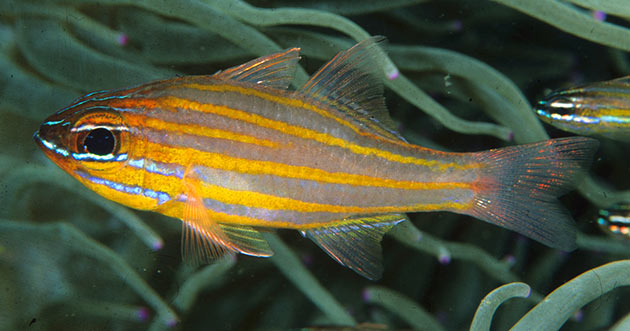
Ostorhinchus cyanosoma |
One way to reduce the chances of damage due to coral or live rock displacement is to cement coral colonies to the reef structure by using one of the hardening agents available to reef keepers. You can also fuse rocks together so that they are more difficult for the fish to move. If you are going to keep “coral-flipping” fishes you should also avoid housing them with fungiid corals as these unattached corals are likely to be turned over (of course, if the coral is large and the potential flipper is small, the fish will be unable to upend the fungiid).
Will the Fish Perch on or Wallow in My Corals?
There are fishes that perch on cnidarians or that wallow among the tentacles of large-polyp scleractinians (e.g., Alveopora, Catalaphyllia, Euphyllia, Goniopora) and the polyps of certain soft corals, Zoanthids and Mushroom Anemones. If a suitable Sea Anemone host is not present, it is not uncommon for Anemonefishes to adopt large-polyped stony corals as surrogate hosts. They will “bathe” in the extended polyps and have also been known to nip and even bite the tips off the tentacles. This behavior can cause the polyp to retract and open sites for bacterial infections. But this association is not always harmful to the coral.
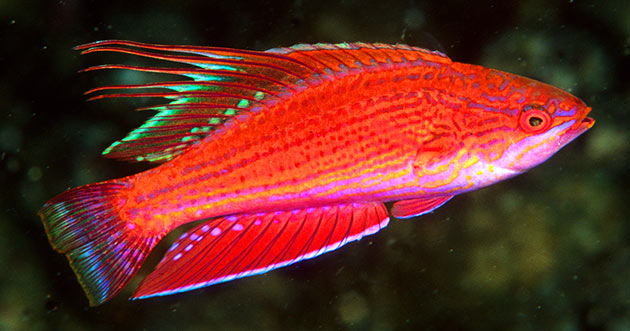
Paracheilinus lineopunctatus |
In fact, Anemonefish might benefit the coral by facilitating water circulation among the coral tissue and by providing nutrients when they excrete urine and feces. They have even been observed protecting their coral companion from fish tankmates that were attempting to nip them. It is likely that a healthy large-polyped stony coral is less likely to be deleteriously impacted by a Clownfish associate, than a colony that is already damaged and/or distressed. If you add an Anemonefish that incessantly “bathes” in a coral’s polyp(s)/tentacles and seems to be causing the polyp to remain retracted, you might want to pull out the fish or remove its unhappy host. Soft corals, Zoanthids and Mushroom Corals are rarely impacted in a negative way by Clownfish symbionts.
While ambush predators that perch on corals are rarely a cause for great concern, on rare occasions they may spend so much time in repose on a specific coral specimen that they negatively impact it. Members of the Frogfish and Scorpionfish families are most often the culprits because they are the least mobile of the sit-in-wait predators. In the wild, they usually change positions when local prey species recognize that they are a threat and begin to avoid them (they often relocate after a number of days). As a result, they don’t spend that much time on any one coral colony. But in the aquarium, they may not have to move at all and there are also far fewer potential ambush sites to select (this is especially true in smaller aquariums).
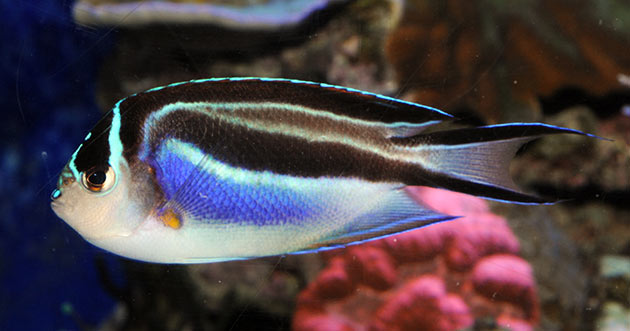
Genicanthus bellus |
If a Frogfish or Scorpionfish remains on a coral colony for many days, and the coral polyps remain retracted, you may want to “haze” the fish. Simply take a piece of rigid tubing or a net and shoo the fish off the coral every time it adopts it as a perch. After being chased off the coral a few times, they will usually choose a place to hang out where they are not bothered.
Will the Fish Cover Corals with Sand or Gravel Substrate When It Feeds or Burrows?
Some fishes may bury your invertebrates as a result of their feeding or burrowing activities. One group that is particularly prone to doing this are the Sleeper Gobies (Valenciennea spp.). When feeding, they take large mouthfuls of sand and eject it out of their gills. Some species also rise up in the water column as the substrate is expelled from the gills. While the Valenciennea spp. are the “king of the sifters,” there are other gobiids that engage in this behavior (including members of the genera Amblygobius, Cryptocentrus, Oplopomus, Oxyurichthys and Signigobius), as do some species of Snappers, Sweetlips, Spinecheeks, Goatfishes, Hemigymnus Wrasses and the Starry Blenny (Salarias stellatus). (The latter takes mouthfuls of sand and the associated diatoms and detritus off the sand bed surface and spits or poops out clouds of sediment.)
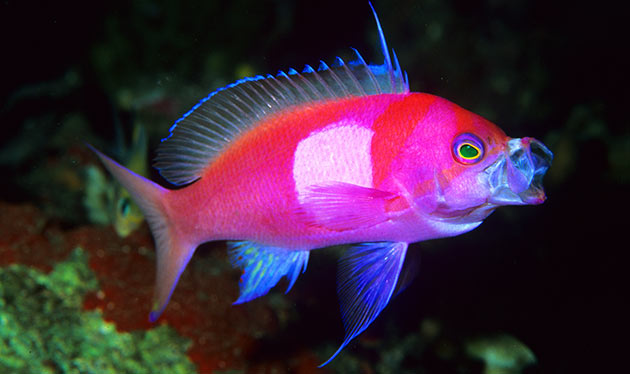
Pseudanthias-pleurotaenia Male |
There is another fish feeding behavior, known as hydraulic jetting, that can lead to sediment settling on corals near the aquarium bottom. This behavior occurs when the fish blows water from their jaws at a spot in the substrate to excavate buried prey. It tends to cause fewer problems for corals than does sand-sifting behavior.
There are also fishes that bury corals when they dig under reef structure to create burrows. For example, Jawfishes and Convict Blennies have been known to bury or topple corals as a result of their excavation activities. The Sleeper Gobies, mentioned above, also use their scoop-like jaws to excavate a burrow under the aquarium décor and have been implicated in coral covering events.
If you keep any of these substrate-disturbing species you should place soft corals (most of which have a difficult time shedding sand) and species of stony corals that are intolerant of silting well away from the aquarium bottom. Those corals that are more tolerant of having sediment “rain” down upon them include members of the following genera: Alveopora, Catalaphyllia, Cynarina, Goniopora, Fungia, Heliofungia, Herpolitha, Polyphyllia, Scolymia, and Trachyphyllia. But even these species should be tilted slightly so that they are better able to shed substrate. While these corals are better adapted to silty environments, they can be damaged if they are constantly being buried by a hungry sand-sifter or vigorous burrower. Other sessile invertebrates that may be affected deleteriously by having substrate deposited on them include Mushroom Anemones, Zoanthids and Clams.
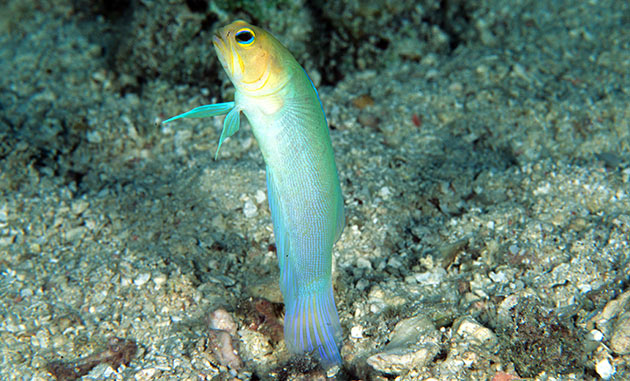
Opistognathus-aurifrons |
Will the Fish Require Frequent Feeding and If So are You Willing to Add Enough Food to Keep Them Healthy?
Some “reefers” feed their aquariums infrequently and rely the flora and fauna associated with the live substrate to provide a supplemental diet for their fishes. Some hobbyists limit feeding because they are concerned the added nutrients will result in poorer water quality and a less healthy environment for their invertebrates. This reluctance was more common when reef aquariums were first gaining popularity, but with the efficacious protein skimmers now available and the use of sand beds and macroalgae in refugia, this is less of a concern. (That said, I recently saw an internet post from an individual that was going to exclude fish from his setup to reduce the number of water changes he would have to administer.)
Even so, there are some fish species that need to be fed more than some hobbyists are willing or able to do. Most of these fish species feed principally on suspended zooplankton and include such species as Anthias (Pseudanthias spp.), Fairy Wrasses (Cirrhilabrus spp.), Flasher Wrasses (Paracheilinus spp.), Pyramid Butterflyfish (Hemitaurichthys spp.) and Swallowtail Angelfishes (Genicanthus spp.). Juveniles of some more active species (e.g., some Wrasses and Goatfishes), as well as the Sleeper Gobies (Valenciennea spp.), have high metabolic demands that will require regular food additions if these demands are going to be met. These fishes feed throughout the day and are unlikely to find enough naturally-occurring food source in the closed marine system.
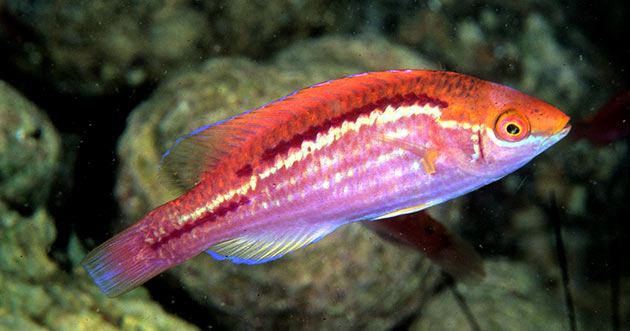
Cirrhilabrus lubbocki |
Therefore, they will need to be fed at least several times a day if they are going to thrive in the reef aquarium. To facilitate feeding efforts, some aquarists have productive refugiums placed “in-line” with their display aquariums. Procreating populations of small crustaceans and other microinvertebrates are transported from the refugium (a “predator free” vessel) into the aquarium that houses the fish population, supplementing food added by aquarists with a natural food source.
While selecting fishes to be kept with corals is not an exact science, answering the questions we have examined in this article should increase your chances of creating a copasetic fish and coral community. With proper planning and close observation, you should be able to assemble a fish population that is not only interesting to watch, but one that will not harm your captive corals!
Part 1:
Understanding Food Habits of Marine Fishes |
| |
Part 2:
Fish Behavior and Habits that Affect Reef Compatibility |

Scott Michael
Scott W. Michael is an internationally-recognized writer, underwater photographer, and marine biology researcher specializing in reef fishes, and was the Banquet Speaker at our 2007 and 2008 Coral Conference and Frag Swap. He is a regular contributor to Aquarium Fish Magazine, Freshwater and Marine Aquarium Magazine, SeaScope, and is the author of Reef Fishes Vol 1, Vol 2, and Vol 3, Vol 4, and Vol 5., A Pocket Expert Guide Marine Fishes, A Pocket Expert Guide to Reef Aquarium Fishes, 101 Best Saltwater Fishes: How to Choose and Keep Hardy, Brilliant, Fascinating Species That Will Thrive in Your Home Aquarium, Reef Sharks & Rays of the World, and Aquarium Sharks & Rays. Having studied marine biology at the University of Nebraska, Scott has served as a scientific consultant for National Geographic Explorer, the Discovery Channel, and French educational television.
References:
Fishelson, L. 1975. Observations on behavior of the fish Meiacanthus nigrolineatus Smith-Vaniz (Blenniidae) in Nature (Red Sea) and in Captivity. Aust. J. Mar. Freshwater Res. 26(3): 329-341.
Losey, G.S. Jr. 1975. Meiacanthus atrodorsalis: field evidence of predation protection. Copeia. 1975(3): 574-576.
Moorhead, J.A. and Zeng, C., 2011. Breeding of the forktail blenny Meiacanthus atrodorsalis: broodstock management and larval rearing. Aquaculture, 318(1), pp.248-252.
Russell, B.C., Allen, G.R., and H.R. Lubbock. 1976. New cases of mimicry in marine fishes. J. Zool. Lond. 180(3): 407-423.
|